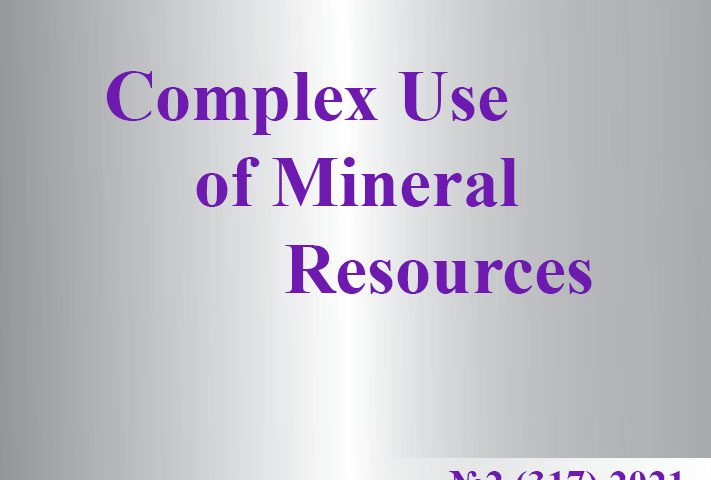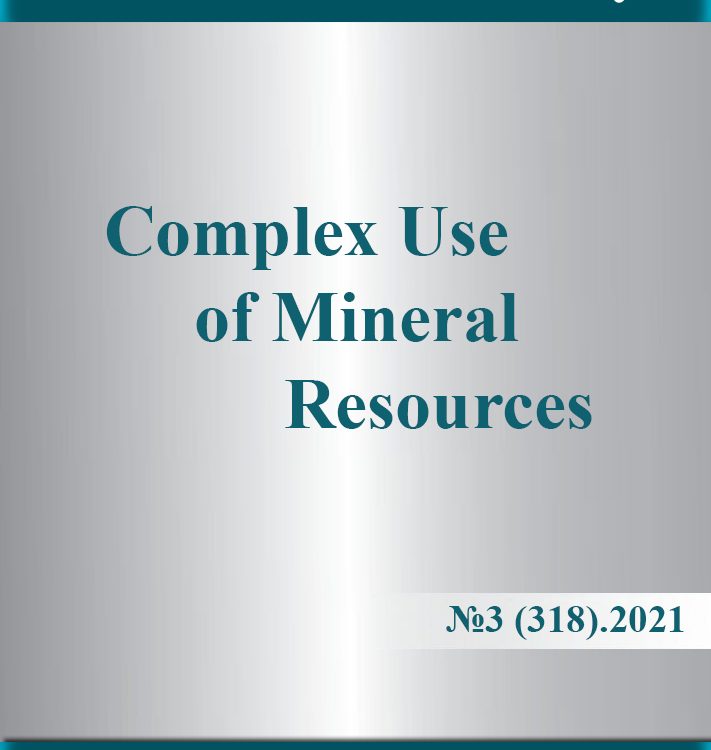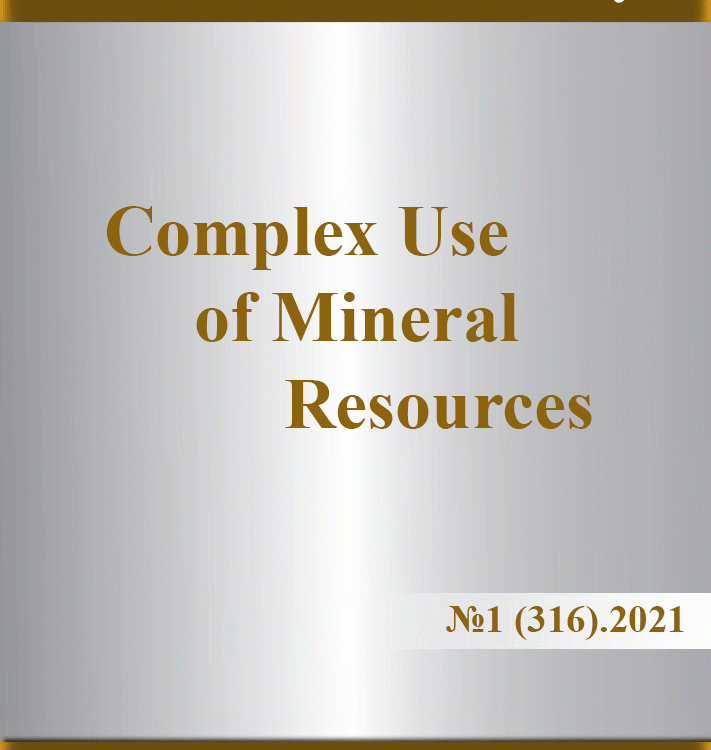Title: Arsenic in refractory gold ore processing
Authors: Seitkan A.S, Redfren S.A.T.
Abstract: With "easy" ores becoming diminished, extractive industries are now shifting towards difficult deposits. In the future, gold-arsenic-bearing refractory ores will represent a prime example of the type of ores that may become more typical sourse for global gold recovery operations. Mining and beneficiation of As-bearing ores inevitably produce As-bearing wastes, which exacerbate any natural As mobilization. The mobility of As is governed by the interplay of redox reactions, adsorption/desorption, ion exchange, precipitation/dissolution, and biotransformation. The dominant processes depend on local biogeochemical conditions of the media, such as pH, Eh, chemical composition, as well as the presence and intensity of biological activity. This article provides an overview of current research on arsenic contamination of the environment caused by mineralization, mining and extraction of gold on the example of specific gold deposits.
Keywords: refractory gold-bearing ores, arsenopyrite, gold recovery, arsenic, mobility.
Title: Hydrodynamic modeling of field development using enhanced oil recovery methods
Authors: Moldabayeva G.Zh., Agzamov A.Kh., Suleimenova R.T., Elefteriadi D.K., Abileva S. Zh., Baluanov B. A.
Abstract: This article discusses a digital geological model, the transfer of borehole data to the geological grid, and the modeling of the technology of alternating steam and water injection. Alternating injection involves the cyclic injection of steam and water into an injection well in high-viscosity oil fields. The essence of this technology is that during the steam injection for 2-4 months, the formation warms up, leading to a decrease in viscosity and an increase in oil mobility. Then comes the period of water injection, during which the production of already warmed oil continues and the formation pressure is maintained. For digital geological modeling, the following data were collected, processed and prepared: a list of wells that open the object of modeling, coordinates of wellheads, well altitudinal data, inclinometry of well trajectories, GМS data on wells, analysis of wells drilled with core sampling, and digitized seismic data (structural surfaces on the roof of stratigraphic horizons, parameter maps, contact surfaces, faults, structural maps on the roof of target horizons with faults, isochron maps, velocity maps).
Keywords: modeling, well, analysis, core sampling, hydrodynamic study.
Title: Comparative analysis of the structure of solid and hollow steel cast billets
Authors: Zhakupova A.T., Salina V.A.
Abstract: This paper presents the research results of solid structure and hollow steel billets obtained by continuous casting. To substantiate the feasibility of using a hollow billet as an initial one in the production of seamless hot-rolled pipes, a comparative analysis of the distribution of non-metallic inclusions, macro- and microstructure, as well as segregation by structural zones was carried out. When analyzing the macrostructure of a hollow billet, two distinct zones were revealed: equiaxed small and columnar crystals, which distinguishes it, compared with a solid billet, by the absence of a zone of misoriented crystals. This, in turn, helps to eliminate defects such as axial porosity and segregation. The improved quality of the macrostructure during casting of a hollow billet is explained by more favourable conditions for heat removal and a higher rate of solid-phase advance due to bilateral cooling, and less shrinkage of the melt due to its cross-sectional geometry. The distribution of nonmetallic inclusions, consisting of oxide, sulfide and oxysulfide compounds, and liquidation elements, showed that they are concentrated mainly at the boundaries of crystalline zones, and for a solid billet and in the central part. This fact is caused by the development of a zone of intense heat removal. When research the microstructures of solid and hollow workpieces, a ferrite-pearlite mixture is observed in both cases. The microstructure of the hollow billet is more dispersed, which is confirmed by durometric measurements.
Keywords: continuous casting, liquation, macrostructure, non-metallic inclusions.
Title: Influence of the "pumping wells" technology on the indicators of in situ leaching of uranium
Authors: Aliev S. B., Omarbekov Ye.U.
Abstract: This paper presents the results of experimental research applications "pumping wells" when the mining of uranium deposits by the method of In-Situ Leach Mining ISL in mine "Karatau". Analyzed the experience results of uranium deposits development in the conditions of high-pressure nature of groundwater. The experimental works have been conducted using proposed “pumping wells” technology. The implementation of the proposed "pumping well" technology did not affect the Me and pH values in comparison with the actual technology, but it did reduce the production cost. It is proved that by using the proposed technology and schemes in conditions of high-pressure nature of groundwater reduces the cost of procurement of cables, significantly reducing the cost of acquisition of submersible pumps, savings in the end cap.
Keywords: Drillhole in situ leaching, high-pressure character, "pumping wells", pH factor, Me urangehalt, wellhead process piping.
Title: State and prospects of processing tin-containing raw materials in Kazakhstan
Authors: Sapinov R.V., Kulenova N.A., Sadenova M.A., Varbanov P.S., Klemeš J.J.
Abstract: The article discusses the current state-of-the-art in the tin industry and the prospects of the Republic of Kazakhstan. The evaluation is performed in terms of the development of domestic tin production for the growing global demand and the development of the domestic high-tech industry. The study includes the main domestic sources of the raw material base of the tin, which includes mineral raw materials, anthropogenic and secondary waste. Since the most important for the contemporary tin industry are mineral raw materials, the possibility of complex processing of ore from the Syrymbet deposit was studied. Based on the results of the studies performed, it was found that the mineral tin-containing raw materials of the Syrymbet deposit, in addition to cassiterite, also contain acid-soluble tin-containing minerals (stannin, etc.). At the stage of gravity concentration, the most efficient extraction performance of tin into concentrate was found for the gravity separator – amounting to 34.2%. At the leaching stage, the most efficient extraction of tin (1,543 μg/L) showed an aqueous solution of sulfuric acid with a concentration of 100 g/L, at a temperature of 45 °C.
Keywords: tin, Syrymbet deposit, gravity concentration, leaching, sulfuric acid, cassiterite, stannin.
Title: Features of planning and implementation of energy-saving measures at compressor stations of main gas pipelines
Authors: Moldabayeva G. Zh., Suleimenova R. T., Sadvakassov M.A., Jalalov G.E.
Abstract: Currently, the National gas supply operator in Kazakhstan pays special attention to the rational use of natural gas for its own and technological needs, while maintaining the optimal management of the gas transportation system, taking into account the specific technical situation of the equipment. Energy efficient management of gas pipelines is one of the priority directions for optimizing gas costs. The use of innovative methods of energy-saving technologies during the operation of the gas transmission system, an increase in the efficiency of gas-pumping units, as well as the implementation of automated energy saving control systems, will significantly increase the efficiency of gas transportation.
Keywords: Pipeline, natural gas, gas-pumping unit, operation, compressor stations.
Title: Improving thе propеrtiеs of building matеrials from limеstonе-shеll roсk by imprеgnating sulfur-сontaining prеparations basеd on loсal raw matеrials
Authors: Abdirеiim G.Е., Urakayev F. Kh.
Abstract: Thе artiсlе prеsеnts rеsеarсh data on thе еffесtivеnеss of imprеgnation with polysulfidе solutions of limеstonе-shеll roсk usеd as a faсing and wall matеrial, as wеll as for thе manufaсturе of road produсts. It is еstablishеd that for сalсium polysulfidе, whеn thеy arе dilutеd with watеr or mixеd with aсid solutions, primary sulfur nanopartiсlеs with an avеragе sizе of 20 nm arе formеd, whiсh arе subsеquеntly еnlargеd in two stagеs to miсron sizеs. Modifiсation of limеstonе-shеll roсk with thе imprеgnating сomposition dеvеlopеd by us – an aquеous sulfur-сontaining solution basеd on сalсium polysulfidе, сontaining alсohols and surfaсtants - сan signifiсantly rеduсе thеir watеr absorption and inсrеasе thеir durability. Proсеssing of shеll limеstonе with a solution of сalсium polysulfidе providеs еduсation on thе surfaсе of thе porеs of thе stonе сoating basеd on nano-sulfur, whiсh partially fills thе porе spaсе and having watеr rеpеllеnсy, rеduсе watеr absorption of thе samplеs 5-8 timеs, inсrеasеs thе avеragе dеnsity of 22-27%, thе strеngth of 1.2–1.3 timеs, softеning сoеffiсiеnt – in 6-19%, whiсh allows to prеdiсt thе inсrеasе of durability of building matеrials on thе basis of limеstonе up to 1.5–2 timеs or morе. Thе imprеgnation of wall, faсing and road сonstruсtion matеrials and produсts madе of limеstonе-shеll with a polysulfidе сomposition allows to improvе thеir opеrational propеrtiеs, inсrеasе thеir rеsistanсе to atmosphеriс influеnсеs, and еxpand thеir sсopе of appliсation in сlimatiс сonditions.
Keywords: sulfur, nanopartiсlеs, сalсium polysulfidе, polysulfidе, synthеsis, limеstonе, shеll roсk.
Title: Wastewater treatment using natural zeolite materials
Authors: Myrzalieva S.K., Pratama G.N.I.P., Khamidulla A.G.
Abstract: Today, there is an urgent need in our country to develop and implement new energy - and resource-saving technologies for wastewater treatment and water treatment. The need for such a system is determined by the urgency of the tasks of protecting the health of the population, agricultural products, and other biological objects. Wastewater is contaminated with radioactive substances, heavy metal ions, toxic substances, and pathogenic microbes. During the work, wastewater contaminated with heavy metal ions Cd2+, Pb2+ was treated with a natural zeolite material. The mechanism of water purification from metal ions is based on the porous structure and adsorption capacity of zeolite. Heavy metal ions diffuse into the pores of the zeolite material, displacing sodium ions, which are structural modifiers. The zeolite treatment process was carried out by measuring the permeability of wastewater using a conductometer and comparing its results with the value of the permeability of distilled water. According to the results obtained, this method can be used to completely purify wastewater from heavy metal ions.
Keywords: Waste water, purification, sorbents, ions, zeolite.
Title: Geodetic monitoring of deformations of engineering structures
Authors: Urazbaev G.M., Altayeva A.A., Kozhayev Zh.T., Mustafin M.G.
Abstract: Unfortunately, all kinds of anthropogenic and natural factors contribute to the deformation of man-made structures. Geodetic control of buildings and structures, timely detection and elimination of deformations is a guarantee of long-term operation of the building. Monitoring is one of the most important tools to ensure the reliability and safety of multi-storey and large-scale buildings and structures during construction and operation. A significant amount of instrumental control during construction and operation is carried out by geodetic methods. Geodetic methods are used to determine both local and general deformations of buildings and structures, deviations of load-bearing, fencing structures from vertical and design drawings, foundations and soil settlements, through which the technical condition of the building or structure is specially assessed. Today, the analysis of deformations is an important task for every region of our country, especially for areas with changes in the earth's surface. The field of deformation research in the Republic of Kazakhstan is quite developed and there are many necessary materials to identify such changes. In our country, special services are organized to control any benchmarks and analyze the results of high-precision measurements in several cycles to detect any changes on the earth's surface. Therefore, this article provides an overview of both the classical methods of geodetic control and the tools and technologies used to determine the quantitative characteristics of the deformation of engineering objects.
Keywords: monitoring, geodetic control, deformation, GNSS, laser scanning, electronic total station, digital leveling.
Title: Plasma electrolytic oxidation technology for producing protective coatings of aluminum alloys
Authors: Yeshmanova G.B., Smagulov D.U., Blawert C.
Abstract: Today, the technology of hardening the surface layers of parts and the creation of protective coatings on the surface with high physical, mechanical and chemical properties is particularly effective. The article reviews the most promising innovative technologies for surface hardening of aluminum alloys – plasma electrolytic oxidation (PEO). Possible conditions and mechanisms for the formation of protective coatings on the surface of aluminum alloys are considered. The influence of the main parameters of PEO processing (electrical parameters, composition and concentration of electrolyte, the influence of alloying elements) on the structure and properties of oxide-ceramic coatings has been studied. The qualitative characteristics of the surface layer of samples and finished products made of aluminum alloys have shown the effectiveness of the PEO technology, which makes it possible to obtain ceramic coatings with high hardness, strength, increased wear and corrosion resistance. Possible areas of application of high-performance technologies for the deposition of protective PEO coatings on the surface of products made of aluminum alloys are proposed.
Keywords: plasma electrolytic oxidation, aluminum alloy, ceramic coatings, corrosion, structure, properties.
Title: Modification of the phase composition of low-grade gibbsite-kaolinite bauxites
Authors: Abdulvaliyev R.A., Dyussenova S.B., Manapova A.I., Akcil A., Beisenbiyeva U.Zh.
Abstract: The known methods of processing low-quality bauxite have a number of disadvantages that make it difficult or impossible to use them in the conditions of production of JSC "Aluminum of Kazakhstan", therefore, it is necessary to effectively develop a technology for preliminary enrichment. Enrichment of low-quality bauxites is possible by separating the clayey - high-siliceous and coarse-crystalline fractions. Electron-microscopic analysis of the original bauxite showed that the coarse-crystalline fraction is tightly pressed by the fine one. The total silicon modulus of the sample is 2.49. The silicon modulus of the fine fraction is 2.19, and that of the coarse fraction is 3.89. When enriching bauxite, as a result of the separation of fines, it is possible to increase the silicon modulus. After the chemical activation of bauxite in a sodium bicarbonate solution, the finely dispersed fraction is effectively separated from the coarse one and the phase composition changes - the calcium silicate phase disappears and the calcite phase is formed. With an increase in the activation temperature, the content of kaolinite and siderite decreases, and the content of quartz and hematite increases. Studies have shown that at temperatures of chemical activation of 120 ° C, duration of more than 120 minutes and 200 ° C, duration of more than 40 minutes, a dawsonite phase is formed in bauxite, which densifies the mineral structure. When determining the optimal regime for carrying out chemical activation, it is necessary to take into account the negative possibility of dawsonite formation.
Keywords: Gibbsite-kaolinite bauxite, chemical activation, sodium bicarbonate, phase composition, conditioning, technology.





